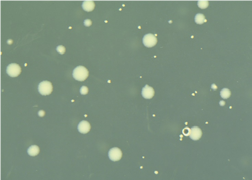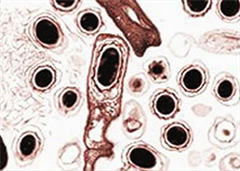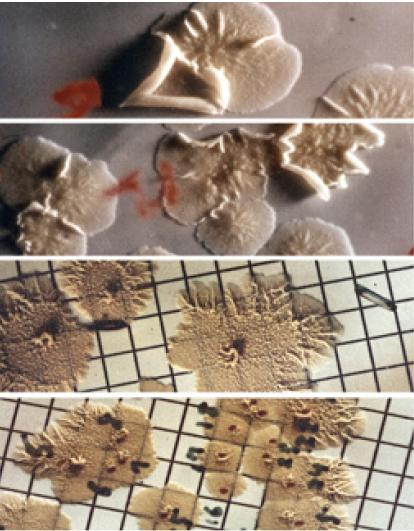
Bacillus thuringiensis is common in soils. It produces toxins that act as natural insecticide and is used to control insects that damage crops. (Used With Permission: J. Johns)
Before we examine what spores are, it’s helpful to understand why we care when it comes to Planetary Protection.
The role of Planetary Protection is to ensure we limit the contamination risk of microbes and organic molecules, or any remnant of terrestrial life, to other planets from Earth. Equally important is that we don’t bring extraterrestrial microorganisms or products of an extraterrestrial biological process (if they exist) back to Earth. One reason is that we wouldn’t want to discover life on Mars only to realize we’d brought it there ourselves! And of course, we never want to bring anything back to Earth that could be harmful to terrestrial life. Preventing biological contamination is sensible, but NASA also requires it because of the International Space Treaty, which says exploration must be done in a way that avoids cross-contamination of other celestial bodies or adverse changes in Earth’s environment.
Why do spores matter so much?
- Spores are considered to be a measure of biological contamination.
- Spores are the most likely candidate to survive microbial reduction treatments (i.e., cleaning and sanitizing).
- Spores are the most likely form of terrestrial life to be able to survive on another planet.
OK, so what is a spore?

Anthrax spores are inactive forms of Bacillus anthracis. They can survive for decades inside a spore’s tough protective coating; they become active when inhaled by humans.
Spores form from certain types of bacterial cells when their survival is at stake. And bacteria are EVERYWHERE on Earth. In the soil, rocks and oceans. Bacteria also live in and on plants and animals, including humans. There are more bacteria in our bodies than human cells. Just one gram of soil could contain 40 million bacterial cells. Bacteria are tiny, barely a few millionths of a meter (a few microns) in length and are invisible except through a microscope. Their existence has both positive and negative effects on us and our environment. For example, “good” bacteria are essential for digesting food while “bad” can cause dangerous infections.
Spores are a survival mechanism for when bacteria are in trouble. That trouble could be because of environmental conditions: excessive heat, cold or a lack of water, or enduring the vacuum of space. The bacterial cell becomes inactive and develops a multi-layered protective coating. Once the spore forms, a process called sporulation, the bacteria can potentially remain dormant for a very long time — germinating after years to centuries. The possibility of a dormant spore reviving after tens of thousands or millions of years remains speculative. When conditions improve, a viable spore can break open, and the bacteria can thrive and reproduce.

Pictures 1 and 2 : Samples of Bacillus subtillus grown during the first performance of Robert Staehle’s experiment (ED-31) aboard Skylab. Pictures 3 and 4: Colonies of the same bacteria that developed during the second performance of the experiment. The experiment determines the effect of the Skylab environment on survival, growth rates, and mutations of certain bacteria and spores.
Because survival is a spore’s mission, they can be tough. There are examples of spore survival at temperatures as high as 220 degrees C to lows of -196 degrees C. Other situations that could cause spores to form include bone-dry conditions (water is necessary for life), high radiation and even exposure to acid and disinfectants. Spores can live through conditions that would be un-survivable to people. Because they’re resilient, they can be challenging to eradicate in situations where it’s crucial to maintain a pristine surface, like the surface of a rover that will land on Mars.
First of all, spores are tiny, about 1 micron across. That’s microscopic and invisible to the naked eye. Imagine a poppy seed, which is 1millimeter across and 1,000 times greater in diameter than a spore). If you scaled a spore up to be the same size as a poppy seed and wanted to show the same density of spores allowed on a spacecraft, you could only have 300 poppy seeds spread across an area of one square kilometer. By international agreement, only 300 spores are allowed to be present per one square meter of spacecraft surface if the mission is going to a celestial body that could support life. That would be the same as 300 poppy seeds spread across 140 soccer fields or about two poppy seeds on a single soccer field!
Second, remember that spores are everywhere and they are tough! Viable spores have been reported recently on the outside of the International Space Station and more research is being done to confirm that discovery. Spacecraft hardware is assembled in cleanroom facilities and frequently wiped with an alcohol solution, then carefully sampled before being taken to the launch pad. Humans are the number one source of contamination in cleanrooms and humans have to build and test every unique spacecraft component. Spores are common in soil and air, so they can be easily transmitted into the cleanroom on shoes or air particles if cleanroom protocols and procedures are not in place. Components that can take the heat, such as the metal wheels, can be heated to a very high temperature to kill spores. NASA mission teams make every effort to be sure that whatever we send to space meets spore requirement thresholds and the risk to other planets we are going to explore is as low as possible.
Remember, spores form around specific bacteria
and make that bacteria inactive. When the spore
“wakes up,” the bacteria can reproduce itself
again. But it can’t become something it isn’t like
a zombie impersonating your best friend, or a
flesh-eating plant or a dinosaur. But those science
fiction movies sure
are fun!
Watch Perseverance Video
Watch Spores Video